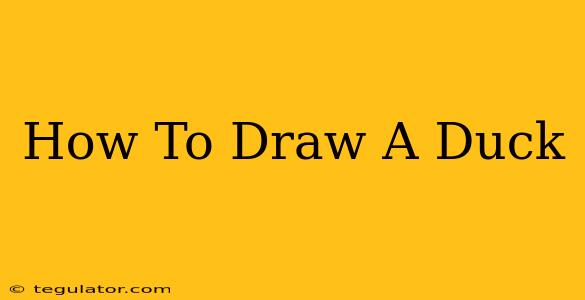So you want to learn how to draw a duck? Whether you're a seasoned artist looking for a new challenge or a complete beginner picking up a pencil for the first time, this guide will walk you through the process step-by-step. We'll cover everything from basic shapes to adding intricate details, ensuring you create a quacking-good drawing!
Getting Started: Materials and Preparation
Before we dive into the drawing process, let's gather our materials. You'll need:
- Paper: Any drawing paper will do, but thicker paper is preferable to prevent smudging.
- Pencil: A standard HB pencil is a great starting point. You might also want a softer pencil (like a 2B) for shading.
- Eraser: A good quality eraser is essential for correcting mistakes.
- Sharpener: Keep your pencil sharp for precise lines.
- Optional: Colored pencils, markers, or paints to add color to your duck drawing.
Step-by-Step Guide to Drawing a Duck
We'll start with a simplified approach, building up complexity as we go.
Step 1: The Basic Shapes
Begin by sketching out the basic shapes that will form the body and head of your duck. Think of a large oval for the body and a smaller circle for the head. Overlap the circle slightly with the oval to connect them.
Step 2: Defining the Body
Refine the oval to create the duck's body. It shouldn't be a perfect oval; add a slight curve to the bottom to create a more realistic shape. Add a small, slightly curved line at the back of the body to represent the tail.
Step 3: Shaping the Head
Now, let's work on the head. Slightly flatten the bottom of the circle to give the head a more natural look. Add a small beak by drawing a triangle shape extending downwards from the bottom of the head.
Step 4: Adding the Legs and Feet
Draw two short, slightly curved lines extending downwards from the bottom of the body. These will be the duck's legs. Add small webbed feet at the end of each leg. These can be simple triangles with small lines indicating the webbing.
Step 5: The Neck and Head Details
Draw a curved line connecting the head and body, forming the neck. Refine the beak by adding a slight curve to the top and bottom. Add a small, round eye near the top of the head.
Step 6: Adding Feathers (Optional)
For a more detailed duck, you can add subtle feather details. Use short, slightly curved lines to suggest the texture of the feathers. Pay attention to the direction of the feathers – they generally flow smoothly along the body.
Step 7: Final Touches and Shading
Erase any unnecessary lines, and refine your drawing. Add shading to give your duck a sense of depth and dimension. Focus on shading the underbelly and parts of the body that would naturally be in shadow.
Different Duck Breeds – Exploring Variations
Once you've mastered the basic duck drawing, you can experiment with different breeds. Each breed has its unique characteristics, such as beak shape, body proportions, and feather patterns. Research different duck breeds online for inspiration.
Beyond the Basics: Adding Color and Background
Once you're happy with your pencil drawing, you can add color using colored pencils, markers, or paints. Consider adding a background to further enhance your artwork. A simple pond or a grassy field would complement your duck drawing perfectly.
Tips and Tricks for Success
- Practice makes perfect: Don't be discouraged if your first attempt isn't perfect. Keep practicing, and you'll see improvement over time.
- Use light pencil strokes: This will make it easier to erase any mistakes.
- Observe real ducks: If possible, observe real ducks to get a better understanding of their anatomy and posture.
- Don't be afraid to experiment: Try different techniques and styles to find what works best for you.
- Have fun! Drawing should be enjoyable. Relax and let your creativity flow.
By following these steps and practicing regularly, you'll be drawing adorable ducks in no time! So grab your pencils and let's get drawing!

